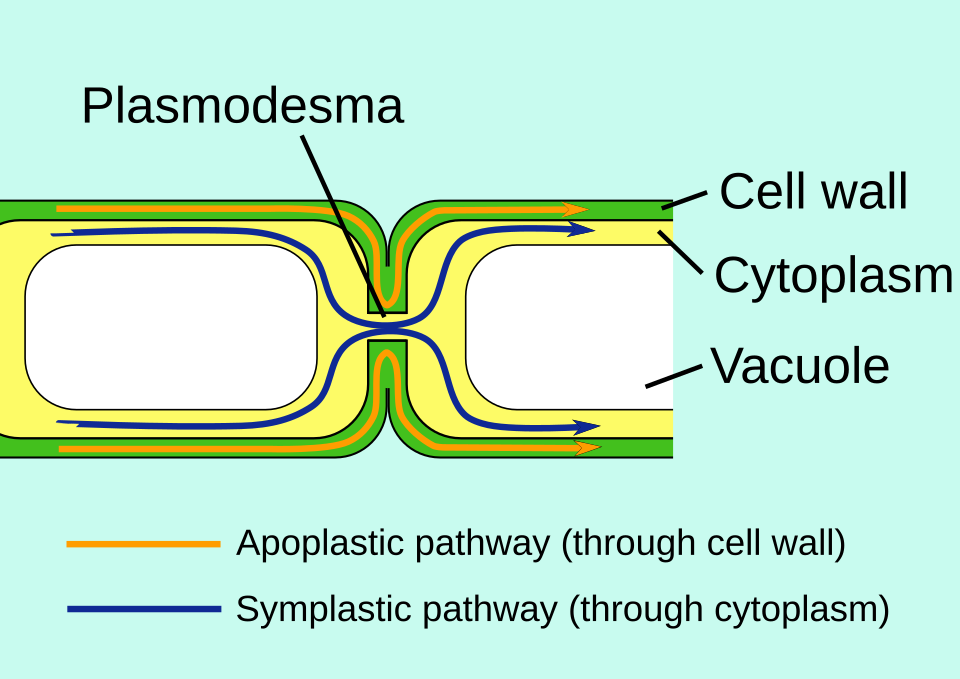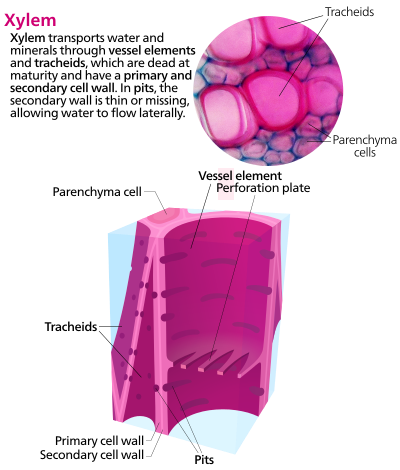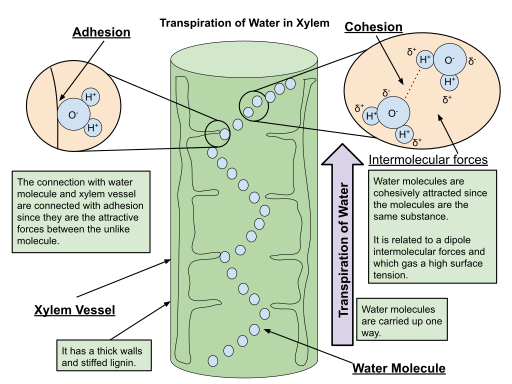OCR Specification focus:
‘Trace apoplast and symplast pathways, and explain water movement using water potential, adhesion, cohesion and the transpiration stream concepts.’
Water transport in plants ensures continuous movement from roots to leaves to sustain photosynthesis, cell turgor, and cooling. This relies on physical forces and specialised tissues.
The Importance of Water Transport
Plants require water for photosynthesis, nutrient transport, and maintaining cell turgidity. Efficient transport systems ensure water reaches all tissues, particularly in tall plants where water must move long distances against gravity. Water movement depends on gradients in water potential, cohesion and adhesion forces, and structural adaptations of xylem vessels.
Water Potential and Its Role in Movement
Water moves by osmosis — from regions of higher water potential to lower water potential across partially permeable membranes. Understanding water potential is key to explaining directional flow.
Water Potential (Ψ): The potential energy of water per unit volume compared to pure water under the same conditions, determining the direction of osmosis.
Water potential is influenced by solute concentration and pressure potential. Pure water has a water potential of zero, and the addition of solutes makes Ψ more negative. Water moves down a gradient, ensuring a continuous flow from soil (high Ψ) to air (very low Ψ).
Pathways of Water Through Plant Tissues
Water can follow three main pathways through root and plant tissues to reach the xylem.

Schematic of water movement via the apoplast (cell walls/intercellular spaces) and symplast (cytoplasm via plasmodesmata) across the root cortex to the xylem. The Casparian strip in the endodermis diverts apoplastic flow into the symplast, enabling selective uptake. Labels are minimal and clean to support OCR learning without extraneous detail. Source.
1. The Apoplast Pathway
Involves water movement through cell walls and intercellular spaces without crossing cell membranes.
The route offers minimal resistance, allowing rapid bulk flow driven by cohesive forces.
The Casparian strip in the endodermis — a waterproof band of suberin — blocks the apoplast pathway, forcing water into the symplast and allowing selective uptake.
2. The Symplast Pathway
Water passes through the cytoplasm of adjacent cells via plasmodesmata (cytoplasmic connections).
Movement is by osmosis along water potential gradients.
This pathway allows control over solute movement and can be influenced by metabolic activity.
3. The Vacuolar Pathway
Water moves from vacuole to vacuole across tonoplasts as well as through cytoplasm.
Slower than the symplast route but significant in maintaining internal equilibrium in cells.
Entry of Water into the Root
Roots absorb water primarily through root hair cells, which have:
A large surface area for absorption.
Thin cell walls for minimal diffusion resistance.
High internal solute concentration, maintaining a steep water potential gradient between soil and root.
Water enters the root hairs by osmosis, passes through the cortex via the apoplast and symplast pathways, and is forced through the endodermis into the xylem vessels, where it joins the upward flow.
The Xylem and Its Role in Water Transport
Xylem tissue is composed of dead lignified cells forming continuous tubes.

Labeled diagram of xylem tissue, highlighting lignified walls, vessel elements, and pits that permit lateral water movement. This structural view complements the physics of the transpiration stream described in the notes. Clean annotations avoid clutter and stay within syllabus scope. Source.
Their structure supports the transpiration stream, a unidirectional flow of water from roots to leaves.
Lignin strengthens walls, preventing collapse under negative pressure.
Pits in vessel walls allow lateral water movement between vessels.
The lack of end walls enables continuous flow, while the absence of cytoplasm reduces resistance.
The Transpiration Stream
The transpiration stream describes the flow of water through the plant, driven by transpiration — the evaporation of water from leaf surfaces.

Diagram of a xylem vessel showing water pulled upwards by transpiration from leaves, with cohesion maintaining a continuous column and adhesion supporting the column against gravity. Arrows indicate upward water movement consistent with the cohesion–tension theory. Clean labels keep the focus on core OCR concepts. Source.
Stages of the Stream
Water uptake by roots from soil.
Movement through cortex into xylem.
Cohesion-tension forces pull water upwards.
Evaporation at mesophyll cell surfaces.
Diffusion of water vapour through stomata to the air.
The stream supplies water for photosynthesis, maintains cell turgidity, and transports mineral ions.
The Cohesion-Tension Mechanism
Water transport in the xylem depends on two main physical properties: cohesion and adhesion.
Cohesion: The attraction between water molecules due to hydrogen bonding, enabling continuous water columns in xylem.
Adhesion: The attraction between water molecules and the hydrophilic walls of xylem vessels, aiding upward movement against gravity.
Mechanism Overview
As water evaporates from leaf cells, tension is created in the xylem.
Cohesive forces pull water molecules upwards to replace lost water.
Adhesion helps water cling to vessel walls, preventing column breakage.
This generates a transpiration pull, maintaining continuous upward flow.
This cohesion-tension theory is supported by measurable negative pressures in xylem and the ability of tall trees to transport water over tens of metres.
Root Pressure
At times of low transpiration (e.g. at night), root pressure can push water upwards. It arises from active transport of ions into the xylem, lowering its water potential so water enters by osmosis from surrounding cells. Root pressure can cause guttation, where droplets appear on leaf edges, but it plays a minor role compared with transpiration pull.
Capillary Action
Capillary action also contributes to water movement in small plants or short distances. It results from the combined effects of adhesion (water attracted to vessel walls) and cohesion (water attracted to itself), drawing water up narrow xylem tubes.
Regulation and Environmental Influence
The rate of water transport is influenced by environmental factors that affect transpiration rate, including:
Light intensity (stimulates stomatal opening).
Temperature (increases evaporation).
Humidity (reduces gradient for diffusion).
Air movement (removes humid boundary layer).
Guard cells regulate stomatal aperture, balancing water conservation with the need for gas exchange.
Summary of Water Transport Mechanisms
Water moves along a continuous gradient from soil to atmosphere.
Transport relies on water potential differences, cohesion-tension, and xylem structure.
Apoplast and symplast pathways ensure both speed and selectivity of water entry.
Transpiration drives the overall stream, linking cellular processes to environmental control.
FAQ
The Casparian strip, found in the endodermal cell walls, is made of suberin, a waterproof substance. It blocks the apoplast pathway, forcing water and dissolved substances to cross the plasma membrane of endodermal cells.
This means ions must pass through selective membrane transport proteins, allowing the plant to control which minerals enter the xylem and preventing harmful substances or pathogens from bypassing cellular regulation.
Cavitation happens when tension in the xylem becomes so great that water columns break, forming air bubbles (embolisms). These block water flow and reduce efficiency.
Plants reduce cavitation by:
Having narrower xylem vessels, lowering the chance of air bubble expansion.
Possessing bordered pits, which isolate embolisms and allow water to bypass blocked areas.
Refilling embolised vessels when transpiration rates drop.
Xerophytes like marram grass and cacti conserve water to sustain transpiration-driven flow. Key adaptations include:
Sunken stomata and rolled leaves to trap moist air.
Thick cuticles reducing evaporation.
Small leaves or spines lowering surface area.
Extensive root systems for water absorption.
These adaptations maintain sufficient water potential gradients for limited but continuous transport through the xylem.
Higher temperatures increase kinetic energy of water molecules, speeding up evaporation from mesophyll cell walls and lowering their water potential.
This creates a steeper gradient for water movement from xylem to mesophyll, enhancing the cohesion-tension pull. However, excessively high temperatures may lead to stomatal closure to conserve water, thereby reducing transpiration despite the increased evaporation potential.
Although water movement in plants covers large distances, no metabolic energy (ATP) is required. The process relies solely on physical forces:
Cohesion between water molecules due to hydrogen bonding.
Adhesion to xylem vessel walls.
Tension generated by transpiration.
Because energy input comes from solar radiation driving evaporation, the mechanism is entirely passive, yet remarkably efficient for transporting water in tall plants.
Practice Questions
Question 1 (2 marks)
Explain why water moves from the soil into the root hair cells of a plant.
Mark scheme:
Water moves by osmosis from a region of higher water potential (in the soil) to a region of lower water potential (in the root hair cells). (1 mark)
Root hair cells contain solutes that lower their internal water potential, maintaining the gradient for water uptake. (1 mark)
Question 2 (5 marks)
Describe and explain how water moves from the roots to the leaves through the xylem, referring to the physical properties of water involved.
Mark scheme:
Water moves through the xylem vessels from roots to leaves as part of the transpiration stream. (1 mark)
Transpiration at the leaf surface creates tension (negative pressure) in the xylem. (1 mark)
Cohesion between water molecules (due to hydrogen bonding) maintains a continuous water column. (1 mark)
Adhesion between water molecules and xylem vessel walls helps the water column resist gravity. (1 mark)
This combination of cohesion, adhesion, and tension forms the cohesion-tension mechanism, pulling water upwards through the plant. (1 mark)

